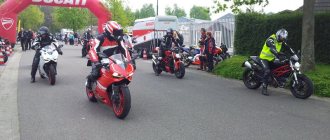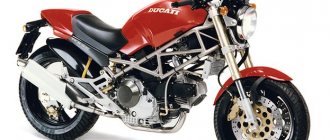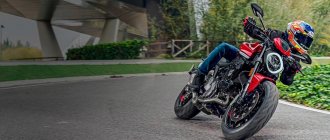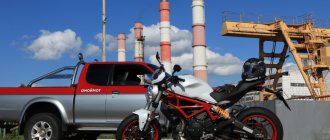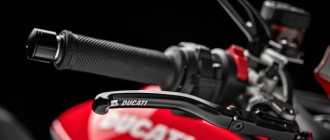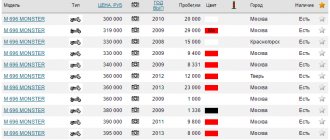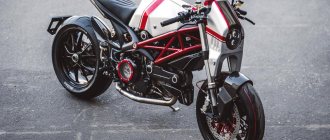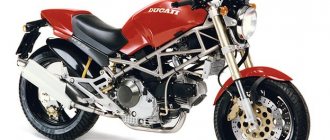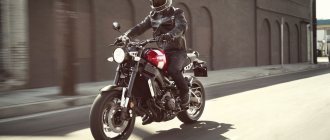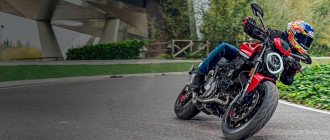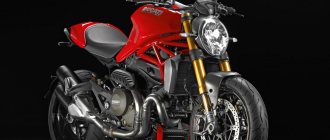Italian motorcyclesDucati motorcycles
The Ducati Monster 400 motorcycle was developed specifically for Japanese consumers. The fact is that the entire line has become particularly popular in the world.
It was decided to create a more miniature and maneuverable model for huge cities.
The result exceeded all expectations. The motorcycle has become a legend not only in Japan, but also in many European countries.
The model has two generations, which are very different from each other. The first generation occurs from 1994 to 2008. The second one was released in 2009.
000_moto_0711_042
Ducati Monster 400: roadster, 1994–2008, 398 cm³, 174 kg, RUB 100,000–200,000.
Ducati Monster 400: roadster, 1994–2008, 398 cm³, 174 kg, RUB 100,000–200,000.
STORY. The smallest “monster” in a large family appeared thanks to the incredible popularity of the model all over the world. A year after the resoundingly successful debut, the company from Bologna decided not to miss such a significant piece of the pie as the Japanese market, and, without further ado, they built a “four hundred” from a six hundred cubic unit, changing only the size of the cylinders. The joy of novice Japanese bikers (for whom more serious cubic capacity was ordered in the first years of their motorcycle career) knew no bounds. It is thanks to the popularity of the model in Japan that we now have a fairly wide selection of “used” 400 “monsters”. In addition to Japan, the “four hundred” were also sold in some European countries, which have rules similar to those in Japan for beginner motorcyclists, but due to the high cost, it is almost impossible to meet a “European” in Russia.
Since the “four hundredth monster” is a rather loose concept, I note that in this article we will consider only the first generation of the motorcycle, authored by Miguel Galuzzi, produced in 1994–2008. The second generation was released in 2009 and is still in production, but structurally it is a completely different motorcycle.
FOR WHAT? It is perhaps impossible to find a motorcycle that is more transparent in its essence. Monster is a purebred naked bike, designed exclusively for moving around the city. The complete lack of wind protection, rigid and short suspension, upright landing and rather sharp geometry of the chassis make it unsuitable even for not very long voyages, driving on broken roads and even carrying a passenger or luggage.
When choosing between the “monster” and the “Yujima” (Japanese in-line “four hundred classics”), you need to realize that in almost all respects the “Japanese” will be better than the “Italian”, starting with engine power (53 hp in the standard Japanese “ four hundred" versus 43 hp for Ducati), ending with the cost of spare parts, consumables and maintenance work. The only parameter by which the “monster” beats all the “Japanese” without exception is, undoubtedly, a very special character, the charisma of the motorcycle and the sensations that it gives both on the move and simply by the fact of its existence. Being different from everyone else is always more expensive than using gray consumer goods. If you are ready to overpay for owning a real “Italian”, albeit small, then this motorcycle is for you. If the question is about buying just an inexpensive “scabies”, then it’s better not to even look in the direction of the “monster”.
The first generation of the “monster” has undergone three major modernizations during its existence. The table of changes illustrates the difference in devices that are similar in appearance.
| TABLE OF MODIFICATIONS | |||
| Ducati Monster 400 | I generation (1994–2000) | II generation (2000–2002) | III generation (2002–2008) |
| Structural base | Monster 600/750 | Monster 620/800 | |
| Fork | Marzocchi, Ø 40 mm | Marzocchi, Ø 43 mm | |
| Clutch | the working cylinder on the right crankcase cover is made with it as a single part | the working cylinder on the left crankcase cover is made as a separate unit | |
| Frame | similar to Monster 600/750, top engine mount with two separate bolts | similar to the Monster 620/800 unit, top engine mount with one through pin | similar to Ducati ST unit |
| Supply system | two Mikuni BDST carburetors, Ø 38 mm | Magneti Marelli fuel injection | |
| Brake system | front disc Ø 320 mm, 4-piston Brembo Gold caliper | most often 2 discs Ø 320 mm, 4-piston Brembo Gold calipers (less often 1 disc) | |
| Dashboard | without tachometer | with tachometer | with tachometer and immobilizer (chip key) |
WHERE TO LOOK? As paradoxical as it may sound, the best place to look for a used “Italian” is in salons selling Japanese second-hand goods, because the vast majority of devices come to us from the Land of the Rising Sun. Of course, it makes sense to look for a motorcycle through private advertisements, that is, with mileage in Russia. However, due to the complexity of servicing the device, there is a fairly serious risk of getting a motorcycle in a tortured state, with diseases that are difficult to treat, so it is highly recommended to take a Ducati specialist with you to the inspection, and not just a motorcycle mechanic. Accordingly, the thoroughness of checks on the “Russified” apparatus should be noticeably higher than when choosing a “Japanese” one.
WHAT TO WATCH FIRST AND WHAT TO FOLLOW LATER?
"-" Mikuni BDST carburetors. The carburetors installed on the first two versions of the Monster are completely identical to those installed on the Yamaha TDM850 and XTZ750 Super Tenere motorcycles.
Their weak point has been known for a long time: due to vibrations that occur during engine operation, the needles in the carburetors break the channels of the main dosing system and the carburetors begin to prepare the mixture incorrectly, which is expressed in its constant over-enrichment, the inability to adjust this parameter and, as a consequence, the impossibility of synchronizing the carburetors. The repair kit will cost 11–12 thousand rubles. Reassembly work with subsequent synchronization will cost another 4–5 thousand rubles. The problem with the power system was solved radically only on the third version of the motorcycle, when fuel injection was installed instead of carburetors. The Magneti Marelli system has proven itself well and does not cause problems during operation.
Everything ingenious is simple
In 1991, the talented designer Miguel Galuzzi, working for Ducati, which at that time belonged to the Cagiva concern, for the sake of experiment, created a motorcycle for himself by completely stripping the 888 sportbike. When Cagiva boss Claudio Castiglioni saw and appreciated what his employee was riding on work, immediately ordered the preparation of the outlandish device for mass production.
It is not known for certain what the plan was to name the motorcycle before Galuzzi Jr. entered the game. The son was very fond of toy monsters and constantly begged for them from his father shouting “Il Monstro, Il Monstro”. The word stuck so well that from a certain point it began to seem like a good name for a new model.
001_moto_0711_042
Mikuni BDST carburetors with well-known sores from the Yamaha TDM850.
Mikuni BDST carburetors with well-known sores from the Yamaha TDM850.
"!" Desmodromic valve actuator. The motorcycle is equipped with the famous desmodromic valve drive. This scheme differs from the traditional one in that the valves open and close forcibly. As a consequence, there is a need for very precise adjustment of the thermal clearances of the opening and closing cams. Maintenance regulations require checking clearances every 5 thousand km and adjusting as necessary. Since an adjustment scheme using measuring washers is used, it is quite difficult to carry out this procedure in a garage environment. The cost of one washer ranges from 160 to 400 rubles. In the service, checking gaps will cost 3 thousand rubles, adjustment - approximately 9 thousand rubles.
"!" Timing drive. The first step after purchasing a motorcycle is to replace the timing belts. In order not to “get” capital money soon after purchase, even if the seller claims that he changed the belts 100 km ago, we consider the belts to be old and change them. The regulations require changing belts every two years, even if the motorcycle has not been driven, or every 5 thousand km (for the first generation) and 10 thousand km with tension control at 5 thousand km (for the second and third generations). It is recommended to check the tension and replace belts only in a service center that works specifically with Ducati. An incorrectly tensioned timing belt promises serious trouble. An overtightened one breaks easily; an undertightened one can jump over a tooth or two. In both cases, a complete “stalingrad” occurs in the cylinder head, entailing the replacement of the piston, head and entire timing mechanism, which is comparable in price to the cost of another motorcycle. Replacing two belts at a service center will cost approximately 3–4 thousand rubles.
Tuning
Tuning a Ducati Monster often revolves around various types of styling; rarely does anyone take the engine and chassis seriously. The maximum that is usually installed is direct flow instead of the standard ones on the muffler (T ermignoni is held in high esteem here), and then only for the sake of a beautiful sound, as well as Dyno Jet in the carburetors. One of the frequent modifications is the installation of a small windshield on the naked versions, as on the S version. Decoration is present everywhere; finding two identical pieces can sometimes be difficult. Everyone chooses the details according to their taste and budget - from branded and branded accessories to inexpensive plastic cladding, colored screws and stickers. Particularly chic are the transparent covers of the drive belts and clutch. Some aesthetically pleasing individuals dilute the moderately bland appearance of the Ducati Monster by radically transforming it from a classic naked bike into an aggressive streetfighter.
002_moto_0711_042
“+” Temperature and oil. The air-cooled engine was developed in hot Italy and for Italy. It is almost impossible to overheat the engine in normal, even “traffic” driving mode. But since “air” engines always have a higher operating temperature than “water” ones, they need to be filled with thicker oil. The optimal choice would be a synthetic oil with a viscosity of 15W50. “Synthetics” are recommended for the long-term health of the nickel coating of cylinders and forged pistons. Therefore, when choosing a motorcycle, you should pay special attention to the freshness and level of oil in the engine crankcase. As you know, nickel cylinders cannot be repaired, and new ones are expensive.
TUNING. With tuning for Monster, things are quite unusual. Ducati always strives to use only the best components from the most renowned manufacturers in its motorcycles. Therefore, it is quite difficult to improve anything in the Monster design. The only tuning “to the point” that can be offered in terms of the ratio “money invested - result obtained” is an increase in engine displacement to 600 cubic meters. On online trading platforms like e-bay, a set of a crankshaft, CPG and cylinder heads (used, of course) costs $500–600. The work to replace these parts will cost another 22–24 thousand rubles. Since the “donor” for the “four hundred” was the 600 cc version of Monster, such implantation is painless and hassle-free both for the engine and gearbox, and for the chassis, because it has an abundance of safety margin.
The second aspect of tuning - decorative - is much richer. For all versions on sale you can find a complete carbon body kit instead of plastic parts and many different baubles. True, all this will have to be ordered from catalogs from Europe or the States. Most likely, nothing will be found in stock at Russian sellers.
PRICES. Returning to the advisability of buying a small “monster”, I note that in showrooms the price tag for an “Italian” is on average 15–20 percent lower than for the same “Seabird” or “Phaser” of a similar year of manufacture and condition. The cost of operating a Ducati is noticeably higher than any Japanese. In addition, if the Yujim can be serviced without any problems in any garage with a minimum set of tools and properly growing hands, then Monster in many cases requires not only a highly qualified master, and not just any one, but specifically trained to work with Ducati, but and special tools. So, even before purchasing a motorcycle, you need to clearly understand where and who will service it.
Prices for used devices start from 100 thousand rubles. for copies of the first generation of the first years of production, but you should not contact them. You will have to pay too much extra to bring it into a “live” form. Upper ceiling - 200 thousand rubles. for injection “monsters” of 2006–2008. In this case, the motorcycle will be in almost perfect condition, but taking into account the fact that for 200–230 thousand rubles. You can already take a completely “live” 620th and even 800th “monster”; the economic sense of the purchase is small.
Every year more and more people pay attention to the “Italians”. In the public consciousness, Ducati in general and Monster in particular ceases to be something insanely expensive and divorced from reality. More and more services offer qualified repair and maintenance services for this equipment. So the demand for the “reds” is slowly but surely growing every year. Naturally, Ducati cannot reach the liquidity of the “Japanese”, comparable to the demand for ice cream on a hot day, but most likely there will be no problems with selling the little “monster”.
Second generation (2008–2013)
The second generation of Italian naked bikes (also called New Monster) was developed from scratch, but at the same time all the family traits were preserved. Motorcycles have lost their sportiness, delicacy and a certain amount of versatility, which allowed them to easily cut through city traffic and roll out onto the race track, leaving behind the qualities inherent in purely urban everyday use. The modern, significantly changed appearance immediately catches the eye. The design was developed by Giulio Malagolli (Miguel Galuzzi had left for Aprilia by that time). High-tech notes are added to the classic forms in the form of sharp edges, sharp transitions and contrasting colors.
Monster 696 (2008–present)
The first model that marked the transition of the “Monster” family to a new generation was the Monster 696, released in 2008. It differs from its predecessor in a different, more dense layout, thicker frame pipes, an aluminum rear subframe, a more powerful and larger engine with upgraded cylinder heads and , naturally, with a significantly redrawn design. There is a version with ABS. Unfortunately, not everyone dares to call this model successful. Seasoned Ducatists, due to the insipid engine, reasonably consider the 696 a motorcycle for girls and dummies.
Monster 795/796 (2010 – present)
To please fans of the brand with a mid-sized motorcycle that rides as well as it looks, the Ducati Monster 795 and Ducati Monster 796 were introduced in 2010 - a symbiosis of the Ducati 696 chassis and the 803 cm3 Desmodue engine. The first version is aimed exclusively at the Asian market and is equipped in exactly the same way as the smaller Monster 696. The 796 is much more technologically advanced; it is distinguished by a cantilever rear wheel mount and light-alloy five-spoke wheels. Anti-lock brakes are available as an option on both motorcycles.
Monster 1100 (2009–2011)
Following the “kids” in 2009, there were a couple of truly monstrous devices - Monster 1100 and its modified version Monster 1100 S. As Malagolli himself said, “The main task that we set for the designers was for the motorcycle to be unmistakably identified as a Monster from 200 meters.” There is not much in common with the 696, only the surroundings, and the engine (the power unit is taken from the Hypermotard 1100 model) and chassis are completely different. The S modification is distinguished by gold-painted wheels, carbon fiber decoration, a fully adjustable Ohlins front fork and an Ohlins rear monoshock, which, unlike the Sachs from the basic version, is connected to the pendulum through progression links.
It makes sense to take a closer look at the Monster 1100 series only for fairly experienced motorcyclists. The combination of low weight (only 169 kg), a very powerful engine, a short wheelbase, super-performance brakes and stiff suspensions constantly provokes aggressive driving and at the same time does not forgive mistakes.
The development of technology has led to the fact that in 2012, the Italian naked bike, as part of the debuting Ducati Monster 1100 EVO, acquired a set of electronic assistants (anti-lock and traction control systems), which are designed to curb the combination of the Desmodue Evoluzione engine (100 hp) with a new exhaust system and Marzocchi front suspension.
The second generation of “Monsters” is in demand on the market due to its freshness. With spare parts and service, things are a little better than with the first one, but not so much that you can turn a blind eye to it. Most of the parts are still not found either in aftermarket sellers or in showrooms of official dealers. Due to the very dense layout and fragile, almost disposable fasteners, service maintenance has become significantly more complicated.
005_moto_0711_042
The front single-disc brake with gold Brembos copes with its duties, but if desired, you can easily install a second disc with a caliper.
All seats on the wheel hub and right fork are available. The front single-disc brake with gold Brembos copes with its duties, but if desired, you can easily install a second disc with a caliper. All seats on the wheel hub and right fork are available.
Motorcycle Specifications
The motorcycle in all its variations had one big advantage: it was ideal as a first experience.
Now some of its technical characteristics may frankly not please you, but due to its excellent simple controls it copes well with the competition.
However, there are a number of obvious disadvantages that are difficult not to mention.
A motorcycle is very difficult to find on the domestic market, and its technical support will cost you a pretty penny. The fact is that the Monster was sold only in Asia and models often reach us in a fairly shabby condition. The Ducati Monster 400 is distinguished by its lack of versatility, alas.
Its capabilities are as great on the road as they are small on rough terrain.
You must remember the truism once and for all - this bike is only for roads and there cannot be any other options.
| Year of issue | 2002 |
| Motor | |
| Type | L-shape, 2 cylinders and 4 strokes |
| Real volume | 398 cc |
| Maximum power/rpm | 43/10 500 |
| Nutrition | Mikuni BDST carburetor (2 pcs.), 3.8 cm diffusers |
| Cooling | Due to air |
| Launch | Electric starter |
| checkpoint | |
| Transfer (main) | Chain |
| Number of steps | 5 |
| Clutch | Oil bath, multi-disc system |
| Running parameters | |
| Frame | Steel, spatial |
| Front suspension type | Inverted telescopic fork (not adjustable) |
| Bore/Stroke | 43/120 mm |
| Rear suspension type | Pendulum with shock absorber (spring adjustable) |
| Move | 130 mm |
| Brake | Separate (hydraulic) |
| Front | Brembo brake 4 pistons (320 mm) |
| Rear | Brembo brake 2 pistons (245 mm) |
| dimensions | |
| Weight | 168 kg |
| Length | 2,050 m |
| Ground clearance | 0.155 m |
| Price (approximate) | 175,000 rubles/$2,500 |
011_moto_0711_042
In a consumer sense, the “Japanese” will be better than the “Italian” in all respects, from engine power to the cost of spare parts.
But Ducati is chosen not with the mind, but with the heart. If the question is about buying just an inexpensive “scabies”, then it’s better not to even look in the direction of the “monster”. In a consumer sense, the “Japanese” will be better than the “Italian” in all respects, from engine power to the cost of spare parts. But Ducati is chosen not with the mind, but with the heart. If the question is about buying just an inexpensive “scabies”, then it’s better not to even look in the direction of the “monster”.
| Estimated cost of spare parts for Ducati Monster 400 | ||
| Name | Original spare parts, rub. | Non-original spare parts, rub. |
| Timing belts, set | 5182 | 6600 |
| Carburetor repair kit | 10000 | — |
| Conversion kit to increase volume up to 600/620 cm3 | 20000 (used, excluding delivery costs) | — |
| Oil filter | 737 | 425 (Hiflo) |
| Air filter | 1079 | 650 (Champion) |
| Brake pads, set | 5240 (Ducati-Brembo) | 2600 (CL Brakes) |
| Spare parts, mostly available in stock. | ||
| Spare parts are sometimes in stock. | ||
| Spare parts, mainly imported to order. | ||
COMPETITORS.
Third generation (2014)
Having been building up intrigue for a long time, Ducati specialists at the end of 2013 at the EICMA international motorcycle show showed their vision of where the “Monster” could go. The new product received a Testastretta engine with a volume of 1198 cm3 and a power of 135 hp. With. from Multistrada 1200 and slipper clutch. In addition to the civilian version, there is a “spurred” S (145 hp). To accommodate this change in caliber, the chassis had to be modified (the wheelbase increased by 60 mm), making the motorcycle more like a heavy Ducati Diavel than a fast and nimble naked bike.
Ducati motorcycles
Ducati is a famous Italian manufacturer of sportbikes and all-terrain motorcycles with an L-shaped engine. The company was founded in 1926 in Bologna. At first, Ducati produced radio equipment, but the factories were destroyed during the Second World War and after it the company began producing engines for motorcycles.
By the end of the 50s, the company successfully competed in motorcycle racing with the powerful Ducati 250 Twin motorcycle. A feature of most Ducati V-twin engines is that the angle between the cylinders is 90 degrees, and one of them is parallel to the ground. This served as the basis for the name of the line of engines - L-shaped.
In addition to the unusual engine, Ducati motorcycles had another feature - the “desmodromic” valve system. This design was developed by engineer Fabio Taglioni, and, largely thanks to it, the company successfully competed in sports competitions. A special feature of this system is the use of a cam drive for the valves. The industry of that time could not provide the required quality of springs for closing valves at high speeds, and the new “desmodromic” system allowed Ducati motorcycles not only to increase efficiency and engine life at high speeds, but also to increase torque at the bottom.
In the 60s and 70s, Ducati continued to compete successfully in racing, improving its sports motorcycles. It was in the 70s that L-Twin engines gained sports fame and became widespread among “civilian” motorcycles.
In 1983, Ducati was acquired by the Castiglioni family and the company merged with the Cagiva group. At this time, Ducati sportbikes continue to be improved and the first model from the Ducati Monstr line of universal motorcycles, which is still popular today, is released.
In the mid-90s, Ducati changed ownership again - the company was acquired by the Texas Pacific investment group. Ducati sports bikes actively and successfully compete in the prestigious World Superbike series.
Success in the World Superbike series pushed Ducati to participate in the MotoGP World Championship. For this purpose, a Ducati Desmosedici GP motorcycle with a V-shaped four-cylinder engine was specially released. In 2007, Ducati wins the MotoGP World Championship.
Now Ducati continues to adhere to the principle of “win a race today, sell a bike tomorrow”, spending about 10% of its budget on sports. Thanks to this spending, the company has a very strong position in sportbikes, superbikes and road bikes. The company is also actively developing enduro motorcycles and cruisers, trying to gain a foothold in new market segments.
Engine
In L-twins, qualified specialists and developers of the Ducati motorbike decided to consistently apply all available and acceptable drive schemes for the upper camshaft, as shown in numerous Ducati Panigale 1199 photos: to begin with, they used schemes with shafts, as well as bevel gears, then switched to schemes with belt, but now the developers have decided to use a standardized circuit with a chain drive.
This has its undoubted advantage, at least for mechanics. For example, there will be much more work for them using the new scheme (according to the statement, service intervals will be equal to 24 thousand kilometers).
There is another revolutionary change that directly affected the design of the engine - this is the transition in the use of working bearings. Previously, these were roller main bearings, but now the developers have switched to plain bearings. It was this solution that made it possible to significantly increase the size and characteristics of the crankshaft journals so as not to inflate the crankcase.
Ducati Panigale
Therefore, the developers of the Ducati 1199 motorcycle did not lie when they stated that the desmodromic drive remained from the old engines, as well as the L-shaped arrangement of cylinders with a 90-degree camber angle.
Although the L-shaped placement in this case can be considered only conditional. The thing is that the developers sought to move the entire power unit as far forward as possible. Due to this, they loaded the front wheel. As a result, the front cylinder rose significantly.
Therefore, it is not so far from the classic and familiar V-shaped placement. Another achievement: weight distribution is 52/48 percent, if we are talking about a person of average fatness.
Specifications
Main technical characteristics of the bike:
- Maximum speed - 228 km/h (speedometer is limited to 299 km/h)
- Fuel tank volume – 15 l.
- Fuel consumption is 5 liters per 100 km. It has a decent power reserve of 300 km.
- The weight of the motorcycle without fuel and operating fluids is 161 kg.
Overclocking for the monster 696 varies depending on the year of manufacture. So for a 2009 motorcycle, acceleration to 100 km/h is 4 seconds, and for a 2012 motorcycle - 4.6 seconds.
| Number of cycles | 4 |
| Number of cylinders | 2 |
| Number of valves per cylinder | 2 |
| Configuration | V-shaped |
| Working volume | 696 cm³ |
| Bore and stroke | 88×57.2 mm |
| Maximum power | 80 hp at 9000 rpm |
| Maximum torque | 69 N/m at 7750 rpm |
| Intake type | Injector |
| Recommended fuel | AI-95 |
| Cooling system | Air |
| Starting system | Electric starter |
| Gearbox type | Mechanical |
| Number of gears | 6 |
| Clutch | Multi-disc, oil bath |
| main gear | Chain |
| Length | 2058 mm |
| Width | 784 mm |
| Height | 1012 mm |
| Seat height | 770 mm |
| Wheelbase | 1452 mm |
| Ground clearance | 117 mm |
| Dry weight | 161 kg |
| Fuel tank capacity | 15 l |
| Frame | Steel spatial |
| Suspension | |
| Front | Inverted telescopic fork |
| Front suspension travel | 120 mm |
| Rear | Pendulum with monoshock absorber |
| Rear suspension travel | 148 mm |
| Ahead | Double disc hydraulic with radial 4-piston calipers |
| Diameter | 320 mm |
| Behind | Hydraulic disc with 2-piston caliper |
| Diameter | 245 mm |
| Tires | |
| Ahead | 120/60 ZR17 |
| Behind | 160/60 ZR17 |
| Discs | |
| Ahead | 3,5×17 |
| Behind | 4,5×17 |
| Country of Origin | Italy |
The motorcycle is equipped with an air-cooled engine with a displacement of 696 cc. cm, which provides decent dynamics.
The bike needs to be broken in, and given the fact that components and spare parts for the Ducati Monster 696 are quite expensive, this process must be carried out strictly in accordance with the manual.
Spare parts can be found on aliexpress or in VK groups.
You will also find the official monster 696 manual in Russian and the abs manual very useful
Why is motorcycle popular?
The Ducati 1199 Panigale S can rightfully be considered one of the best, and even revolutionary models of sports superbikes. It was created specifically for races and prize-winning places in championships such as World Superbike, and almost immediately adapted for frantic, but relatively calm riding on public roads.
What is especially pleasing is that the motorcycle was ultimately able to exceed even the most daring and daring expectations in terms of power, performance, design and handling. The only thing that slightly spoiled the performance was the cost of the motorcycle. Due to the inflated cost, the motorcycle was not entirely accessible to the general public.
Of course, the creators took this nuance into account, and that is why they created the Ducati 899 Panigale. It was the same motorcycle, but it was only made as a budget version. As for the Ducati Panigale 1199, it remains a source of pride for extreme sports enthusiasts, as well as an object of worship for consumers.
Ducati Panigale 1199
Motorcycle Monster 400
The beginning of a whole category of neoclassical motorcycles was laid by the Ducati Monster 400 model. The design of the motorcycle was completely absent of any fairings or decorative elements, leaving only a bare engine and frame in appearance. The appearance of this bike in the early 1990s created a new class of naked motorcycles.
The model weighing 184 kilograms was equipped with a 78 horsepower engine, which allowed the motorcycle to accelerate to 210 km/h with an acceleration dynamics of 3.5 seconds.
The Ducati Monster 400 lived up to its name, combining excellent handling, audacity and power. The motorcycle's temper, however, turned out to be too frightening for most motorcyclists, which is why the company introduced the 600th model to the market in 1995. No changes were made to its design, but in terms of handling and technical characteristics it was softer and friendlier.
Versions with 400 cc engines with a capacity of 53 horsepower were produced especially for the Japanese market - novice motorcycle enthusiasts in Japan are allowed to drive motorcycles with exactly this cubic capacity.
Owners of Ducati Monster motorcycles said in their reviews that the release of this model marked the beginning of the concern's return to its roots: engineers launched a road motorcycle model similar to earlier models - Elite, Marianna and Scrambler.
The excellent combination of innovative and refined solutions from Ducati engineers was also noted - the proprietary frame previously used in the 851 and 888 models, and the Supersport engine with an air-oil cooling system.
Possible motorcycle malfunctions
The motorcycle is characterized by specialists and owners as quite reliable and not causing much trouble. The most common malfunctions:
- Melting of the plastic screen and fuel line pipes located next to the exhaust. The repair consists of installing additional thermal insulation.
- The engine crankcase may be damaged at the side stand attachment point. If detected, replacement is required.
- Destruction of steering limiters. They are restored by removing old parts and installing new ones.
You can purchase original Ducati Monster 696 spare parts and have them repaired at the company’s specialized services.
Model range overview
The model has only one purpose - it is a naked bike designed for city roads. It gets the job done perfectly, but don't expect amazing sport or cruising performance.
The motorcycle was not equipped with any wind protection or variable riding position. You can sit up straight, period. The suspension is short and very stiff, and the chassis has a very sharp shape.
It is important to remember that the Italian Ducati Monster 400 bike is inferior to Japanese motorcycles in almost all characteristics. If you don’t particularly care about the character of the motorcycle, its temper, and you just want a vehicle, then the Monster is not for you
If you don’t particularly care about the character of the motorcycle, its temper, and you just want a vehicle, then the Monster is not for you.
It will suit people who are willing to pay more for a real Italian “horse” and not ride another inconspicuous Japanese horse.
At one time, the four hundredth caused more than just a resonance. After its resounding rise, other manufacturers began to create its analogues en masse, thereby confirming the winning concept.
The bike was eye-catching in appearance: the frame was a rough design made of tubes, a la a bird’s “cage,” and the engine was defiantly “exposed.”
At its core, the concept was not new. Such technologies, in a sense, returned the model to its roots and combined race-tested elements. What is the beauty of this beast?
Despite the power and very nimble disposition, the motorcycle is excellently controlled.
Initially, many were afraid of the Monster, as they considered it unsafe; for such people, a year later the developers released the six hundredth model, calmer and slower.
The motorcycle has a very smooth start, the ride itself is smooth and very pleasant (we are not talking about broken country roads, but rather about highways).
If you try, you can get yourself a quick start, but in 2-3 gears the motorcycle won’t be in much of a hurry. And it will only gradually pick up speed.
The bike handles holes very poorly, especially deep ones. It hits the front wheel disc noticeably and can create the feeling that the tire has gone flat. But no, it's just designed for normal roads.
Despite the fact that the early models are already quite outdated, working systems work flawlessly.
The bike is very competently limited in speed: if at 120 km/h you can move calmly without feeling any problems at all, then at 145 km the monster will start howling and you will hardly be able to ride like that for a long time.
After fully mastering the bike, you may be tempted to race it, and the bike may even disappoint you. But everything in this system is not without reason: at 120 km/h you are already moving quickly, but you can calmly control the situation on the road. It's the perfect balance.
Features of the Yamaha Diversiya 600 motorcycle, with a 125 cc engine. cm.
Honda motorcycle with automatic transmission features and disadvantages of automatic transmission.
